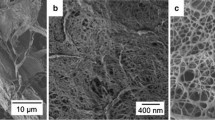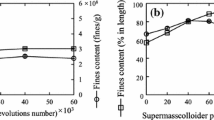Abstract
This study reports the production of cellulose nanofibrils (CNF) from a bleached eucalyptus pulp using a commercial stone grinder. Scanning electronic microscopy and transmission electronic microscopy imaging were used to reveal morphological development of CNF at micro and nano scales, respectively. Two major structures were identified: (1) highly kinked, naturally helical, and untwisted fibrils that serve as backbones of CNF networks, and (2) entangled, less distinctively kinked (or curled) and twisted “soft looking” nanofibrils. These two major structures appeared in different features of CNF network such as “trees”, “net”, “flower”, single fibril, etc. Prolonged fibrillation can break the nanofibrils into nanowhiskers from the untwisted fibrils with high crystallinity. Energy input for mechanical fibrillation is on the order of 5–30 kWh/kg. The gradual reduction in network size of CNF with time may be used to fractionate CNF.










Similar content being viewed by others
References
Agarwal UP, Reiner RS, Ralph SA (2010) Cellulose I crystallinity determination using FT-Raman spectroscopy: univariate and multivariate methods. Cellulose 17(4):721–733
Bai W, Holbery J, Li K (2009) A technique for production of nanocrystalline cellulose with a narrow size distribution. Cellulose 16(3):455–465
Dekker J (2003) New insights in beating leading to innovative beating techniques. 7th PIRA International Refining Conference, Stockholm, Sweden
Eichhorn SJ, Dufresne A, Aranguren M, Marcovich NE, Capadona JR, Rowan SJ, Weder C, Thielemans W, Roman M, Renneckar S et al (2010) Review: current international research into cellulose nanofibres and nanocomposites. J Mater Sci 45(1):1–33
Franson MH (1985) Standard methods for the examination of water and wastewater, 16th edn. American Public Health Association (APHA), Washington, DC, pp 532–537
Habibi Y, Lucia LA, Rojas OJ (2010) Cellulose nanocrystals: chemistry, self-assembly, and applications. Chem Rev 110(6):3479–3500
Hartman RR (1985) Mechanical treatment of pulp fibers for paper property development. In: Punton V (ed) Mechanical Engineering Publications Limited, Oxford, England, pp 413–442
Henriksson M, Berglund LA, Isaksson P, Lindström T, Nishino TD (2008) Cellulose nanopaper structures of high toughness. Biomacromolecules 9:1579–1585
Iwamoto S, Nakagaito AN, Yano H (2007) Nano-fibrillation of pulp fibers for the processing of transparent nanocomposites. Appl Phys A Mater Sci Process 89:461–466
Iwamoto S, Abe K, Yano H (2008) The effect of hemicelluloses on wood pulp nanofibrillation and nanofiber network characteristics. Biomacromolecules 9(3):1022–1026
Kerekes RJ (2005) Characterizing refining actions: linking the process to refining results. 8th PIRA International Refining Conference, Barcelona, Spain
Klemm D, Kramer F, Moritz S, Lindstrom T, Ankerfors M, Gray D, Dorris A (2011) Nanocelluloses: a new family of nature-based materials. Angew Chem Int Ed 50(24):5438–5466
Law KN, Lo SN, Valade JL (1985) Beating behavior of sulphite-mechanical hardwood pulps. Pulp Paper Canada 86(1):70–74
Marton R, Goff S, Brown AF, Granzow S (1979) Hardwood TMP and RMP modifications. TAPPI 62(1):49–53
Mazumder BB, Ohtani Y, Cheng Z, Sameshima K (2000) Combination treatment of kenaf bast fiber for high viscosity pulp. J Wood Sci 46(5):364–370
Nakagaito AN, Yano H (2004) The effect of morphological changes from pulp fiber towards nano-scale fibrillated cellulose on the mechanical properties of high-strength plant fiber based composites. Appl Phys A Mater Sci Process 78:547–552
Pääkkö M, Ankerfors M, Kosonen H, Nykänen A, Ahola S, Österberg M, Ruokolainen J, Laine J, Larsson PT, Ikkala O et al (2007) Enzymatic hydrolysis combined with mechanical shearing and high-pressure homogenization for nanoscale cellulose fibrils and strong gels. Biomacromolecules 8(6):1934–1941
Panshin AJ, de Zeeuw C (1980) Textbook of wood technology. McGraw-Hill Book Company, New York
Saito T, Hirota M, Tamura N, Kimura S, Fukuzumi H, Heux L, Isogai A (2009) Individualization of nano-sized plant cellulose fibrils by direct surface carboxylation using TEMPO catalyst under neutral conditions. Biomacromolecules 10(7):1992–1996
Siró I, Plackett D (2010) Microfibrillated cellulose and new nanocomposite materials: a review. Cellulose 17:459–494
Siró I, Plackett D, Hedenqvist M, Ankerfors M, Lindström T (2011) Highly transparent films from carboxymethylated microfibrillated cellulose: the effect of multiple homogenization steps on key properties. J Appl Polym Sci 119(5):2652–2660
Stamm AJ (1964) Wood and cellulose science. The Ronald Press Company, New York, p 549
Stelte W, Sanadi AR (2009) Preparation and characterization of cellulose nanofibers from two commercial hardwood and softwood pulps. Ind Eng Chem Res 48(24):11211–11219
Tejado A, Alam MN, Antal M, Yang H, van de Ven TGM (2012) Energy requirements for the disintegration of cellulose fibers into cellulose nanofibers. Cellulose 19(3):831–842
Turbak AF, Snyder FW, Sandberg KR (1983) Microfibrillated cellulose, a new cellulose product: properties, uses, and commercial potential. J Appl Polymer Sci; Appl Polym Symp 37:815–827
Uetani K, Yano H (2011) Nanofibrillation of wood pulp using a high-speed blender. Biomacromolecules 12(2):348–353
Wegner TH, Jones EP (2009) A fundamental review of the relationships between nanotechnology and lignocellulosic biomass. In: Lucia LA, Rojas OJ (eds) The nanoscience and technology of renewable biomaterials, 1 st edn. Wiley, New Jersey, pp 1–41
Zhu JY, Sabo R, Luo X (2011) Integrated production of nano-fibrillated cellulose and cellulosic biofuel (ethanol) by enzymatic fractionation of wood fibers. Green Chem 13(5):1339
Zimmermann T, Pöhler E, Geiger T (2004) Cellulose fibrils for polymer reinforcement. Adv Eng Mater 6(9):754–761
Acknowledgments
We acknowledge the financial supports by a USDA Agriculture and Food Research Initiative (AFRI) Competitive Grant (No. 2011-67009-20056) and Chinese Scholarship Council (CSC). The funding from these two programs made the visiting appointment of Wang at the USDA Forest Products Laboratory (FPL) possible. We also acknowledge Ann Masco of FPLL Paper Test Lab for FQA analysis. The authors also wish to thank Anne Kamata, SAIC-Frederick, Inc. for electron microscopy imaging. TEM imaging work was funded in whole or in part with federal funds from the National Cancer Institute, National Institutes of Health, under Contract No. HHSN261200800001E. The content of this publication does not necessarily reflect the views or policies of the Department of Health and Human Services, nor does mention of trade names, commercial products, or organizations imply endorsement by the US Government.
Author information
Authors and Affiliations
Corresponding author
Additional information
This work was conducted on official government time of Zhu, Gleisner, and Kuster. Wang was a visiting student at the USDA Forest Service, Forest Products Laboratory.
Rights and permissions
About this article
Cite this article
Wang, Q.Q., Zhu, J.Y., Gleisner, R. et al. Morphological development of cellulose fibrils of a bleached eucalyptus pulp by mechanical fibrillation. Cellulose 19, 1631–1643 (2012). https://doi.org/10.1007/s10570-012-9745-x
Received:
Accepted:
Published:
Issue Date:
DOI: https://doi.org/10.1007/s10570-012-9745-x




